Traditional and contemporary Korean art under spotlight in L.A.
By Park Min-youngPublished : June 6, 2011 - 19:05
LACMA expands Korean art gallery and REDCAT Gallery showcases works by Kim Beom
LOS ANGELES ― Four conservators were sprawled on the floor at the Los Angeles County Museum of Art’s Korean art gallery, concentrating on their brush tips. They have been restoring “Buddha Shakyamuni Preaching to the Assembly on Vulture Peak,” an 18th century Korean Buddhist painting, since last August.
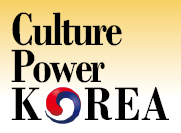
“Since 2000, the museum has been sending me to Korea works that needed restoration and this year they brought me here. Visitors can actually see us work, so I think it is a great idea for education and also for the promotion of Korean art,” said Park Chi-sun, professor at the department of conservation of cultural properties at Yong-In University in Yongin City, Gyeonggi province. She brought five conservators along with her to work on the project during her sabbatical.
LOS ANGELES ― Four conservators were sprawled on the floor at the Los Angeles County Museum of Art’s Korean art gallery, concentrating on their brush tips. They have been restoring “Buddha Shakyamuni Preaching to the Assembly on Vulture Peak,” an 18th century Korean Buddhist painting, since last August.

“Since 2000, the museum has been sending me to Korea works that needed restoration and this year they brought me here. Visitors can actually see us work, so I think it is a great idea for education and also for the promotion of Korean art,” said Park Chi-sun, professor at the department of conservation of cultural properties at Yong-In University in Yongin City, Gyeonggi province. She brought five conservators along with her to work on the project during her sabbatical.
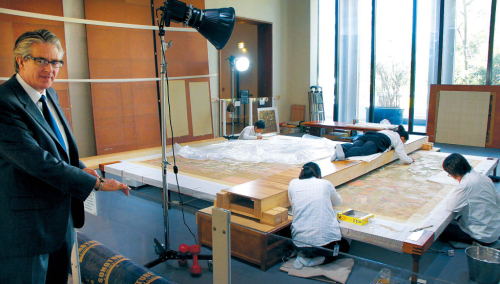
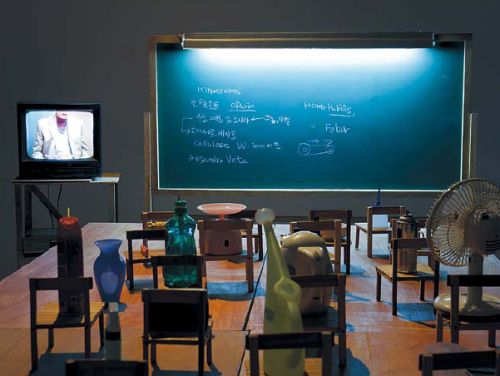
“There is always something new going on in the Korean art gallery. When the conservation project is finished, we will have a big celebration with food and music and festivals,” said Michael Govan, CEO and director of LACMA.
He handed The Korea Herald his “Korean business card” which had his name and title written in Korean.
“At my work, I see more Korean than English. More Koreans are here except for in Korea. Focusing on Korean art was just right for both local and global investment,” he said.
Korean traditional art in pride of place at LACMA
LACMA, located on 5905 Wilshire Boulevard just a few blocks away from the Korean Cultural Center in L.A., is the largest art museum in the western U.S. and has one of the best and biggest Korean art galleries in North America. The beginnings of its Korean art gallery, however, were humble.
“On the day of the opening (of LACMA), the Korean first lady (Yuk Young-soo, wife of former President Park Chung-hee) came to the opening and realized that there was not a single Korean work. So she made a little gift, donated a ceramic and that was our first collection of Korean artwork,” said Govan.
The Korean art gallery opened in 1978, 13 years after the establishment of LACMA. The gallery was revamped twice and the last renovation in 2009 expanded its size from about 185 square meters to 622 square meters.
Now located on the first floor of the Hammer Building, the gallery has a very Korean ambience starting from its entrance where Korean-style wooden windows are flipped up. The walls are finished with wood and the paper used in the showcases is “hanji,” or Korean traditional mulberry paper.
The museum owns about 1,295 Korean artworks including historically important pieces such as “Deoksewi, 153rd of the 500 Nahans,” a hanging scroll, and “Seated Amita Buddha,” a wooden sculpture, both from the Joseon Dynasty. About 10 percent of the collection is currently on display.
“Compared to the Korean galleries in the Metropolitan Museum of Art, The Art Institute of Chicago, San Francisco Museum of Modern Art or the Honolulu Academy of Arts, LACMA has the best collection of Joseon paintings and Buddhist paintings and landscape paintings,” said Stephen Little, curator and head of LACMA’s Chinese and Korean Art Department.
Since the 1990s, LACMA has been showing keen interest in Korean art. It put Korean curators in charge of the Korean Art gallery and has kept a good relationship with the Korea Foundation, the National Museum of Korea and several Korean companies.
Govan, who took his position at the museum in 2006, said that the clarity and simplicity of Korean art mesmerized him.
“When I was in art school, I had fair interest in Korean ceramics, especially Joseon ceramics and white ware. It seemed to be good for anytime and anyplace,” he said.
LACMA is holding the exhibition “Elegant Simplicity” in the Korean art gallery until Sept. 12. It exhibits furniture and ceramics from the AMOREPACIFIC Museum of Art. The Korean cosmetics brand signed an MOU with LACMA in March to provide $200,000 every year for five years for LACMA to buy Korean contemporary art. In 2008, the company donated $300,000 for the establishment of a Women’s Quarter in the Korean art gallery, which now exhibits traditional accessories used by women.
The museum is also planning to hold a special exhibition on Korean art by borrowing from Leeum, Samsung Museum of Art’s Korean traditional art collections about one or two years from now.
L.A. gets Korean contemporary art
In LACMA’s Broad Contemporary Art Museum, which showcases contemporary artwork by artists from all around the world, works can be found by Korean artists Yang Haegue and Suh Do Ho.
Yang’s mixed media installation “Doubles and Couples” made of a boiler, a laundry machine, a gas stove, a refrigerator and a shower room was spread out in the middle of a room and Suh’s light purplish “Gate” which took its motif from the artist’s parents’ house in Seoul caught attention in another.
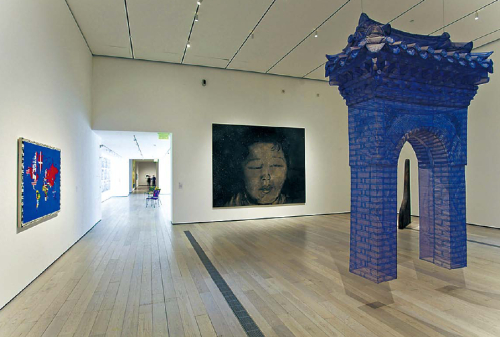
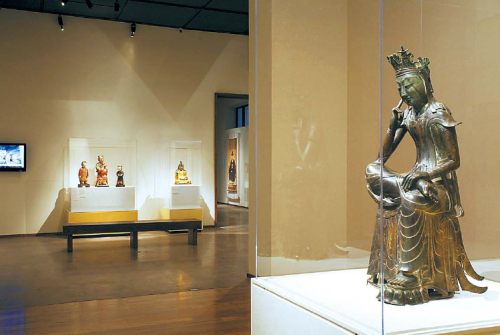
Suh is planning to make a huge house based on Gyeongbokgung, a Joseon palace, to exhibit at LACMA. The staff will meet him this month for further discussions, said Little.
Little mentioned artwork by Choi Woo-ram, a Korean artist known for his “anima machines,” whose work he saw in Tokyo.
“They were strange, life-like creatures with wonderful moves. I hope to show his works here one day. They would be very popular. Some of the best contemporary art in the world is from Korea,” he said.
Govan emphasized that Korean art is growing in cultural importance and LACMA’s focus is not just on traditional art but also on contemporary art.
“LACMA has one of the best collections of Korean art outside of Korea. We have held several shows on Korean art, each time focusing on different art such as contemporary art, traditional art, architecture and young artists. I also want to know more about video works by Korean artists. The commitment to Korean art is not just one show, it is ongoing,” said Govan.
“LACMA is one of the biggest museums in the U.S. but also by far the youngest. We will be a museum of art history but with a very contemporary approach. We are rebuilding this museum in a very different attitude. Now Asia is huge, so is Latin America. Korean art and Asian art will have a primary role and so will Latin America art. In terms of world view ― ours will be very different.”
Korean contemporary artist Kim Beom’s exhibition “Kim Beom: Animalia” which runs through June 19 at REDCAT Gallery in downtown L.A. was covered by local media, including the Los Angeles Times. Funded primarily by the Korea Foundation and organized by curator Clara Kim through collaboration with the Cleveland Museum of Art, the exhibition features several installations, videos and drawings by the artist.
Among them, a series of sculptural tableaux titled “Educated Objects” is witty enough to have viewers crack up after taking in the meaning. In one, about a dozen everyday household products including a watering pot, a detergent bottle and a fan are each sitting on a chair, facing a chalkboard on which words like “Hippocrates” and “Homo Habilis” are scribbled. A professor who appears in the TV set next to the chalkboard is vigorously teaching them a lesson that “they are nothing but tools.”
The piece titled “A Rock That Was Taught It Was A Bird” features a rock placed on a branch of a tree, and the work “A Rock That Learned the Poetry of JUNG Jiyong” shows a video strip of a professor reading Korean poet Jung Ji-yong’s poems to a rock.
“So don’t you ever think that you are a rock. Would you prefer to be a rock? Dirt and rock are the least important things in the world!” the professor scolds the world. He speaks in Korean but the video has English subtitles.
Clara Kim said that the artist explores social education and development psychology through the series.
“The materials that I use are often about Korea but the overall themes are universal. I think that is why foreigners can easily understand my works,” said Kim Beom.
In another work, a video work titled “Spectacle,” Kim smartly inversed the power dynamics in nature by editing a video strip of a cheetah chasing an antelope. In his completed work, it is the antelope that chases the cheetah.
Aram Moshayedi, a curator at REDCAT Gallery, said that Kim’s works are comprehensible and very interesting.
“I don’t know Jung Ji-young but I think it is really funny especially with the video which zooms into the rock ... It is a humorous inversion,” he said.
By Park Min-young , Korea Herald correspondent
(claire@heraldcorp.com)







![[Graphic News] More Koreans say they plan long-distance trips this year](http://res.heraldm.com/phpwas/restmb_idxmake.php?idx=644&simg=/content/image/2024/04/17/20240417050828_0.gif&u=)
![[KH Explains] Hyundai's full hybrid edge to pay off amid slow transition to pure EVs](http://res.heraldm.com/phpwas/restmb_idxmake.php?idx=644&simg=/content/image/2024/04/18/20240418050645_0.jpg&u=20240419100350)





![[From the Scene] Monks, Buddhists hail return of remains of Buddhas](http://res.heraldm.com/phpwas/restmb_idxmake.php?idx=652&simg=/content/image/2024/04/19/20240419050617_0.jpg&u=20240419175937)

![[KH Explains] Hyundai's full hybrid edge to pay off amid slow transition to pure EVs](http://res.heraldm.com/phpwas/restmb_idxmake.php?idx=652&simg=/content/image/2024/04/18/20240418050645_0.jpg&u=20240419100350)

![[Today’s K-pop] Illit drops debut single remix](http://res.heraldm.com/phpwas/restmb_idxmake.php?idx=642&simg=/content/image/2024/04/19/20240419050612_0.jpg&u=)